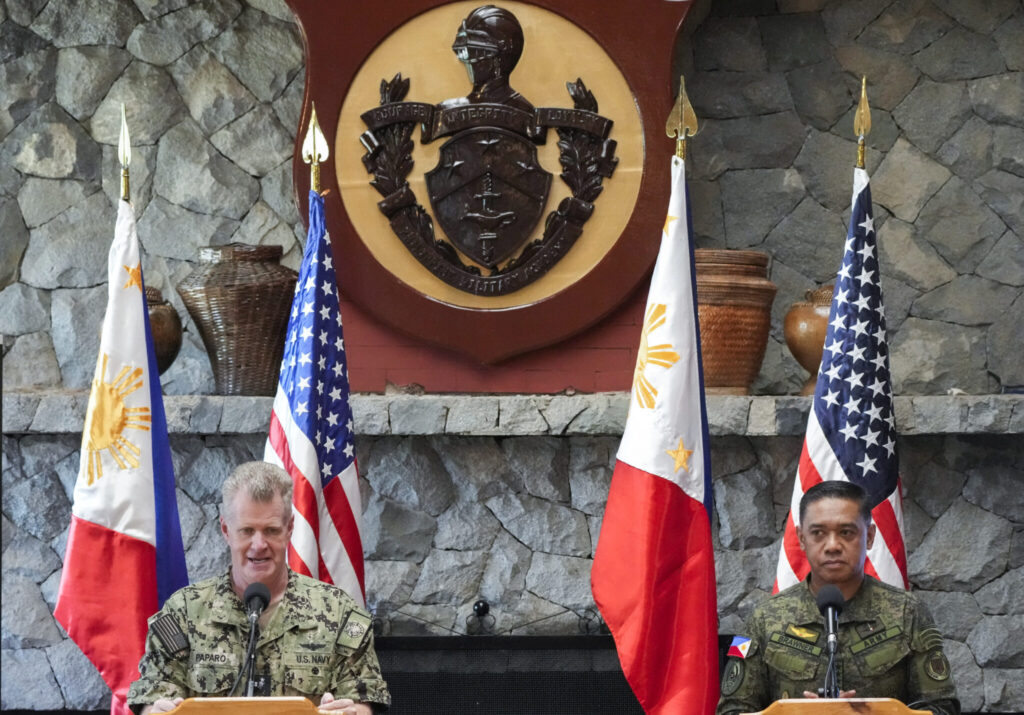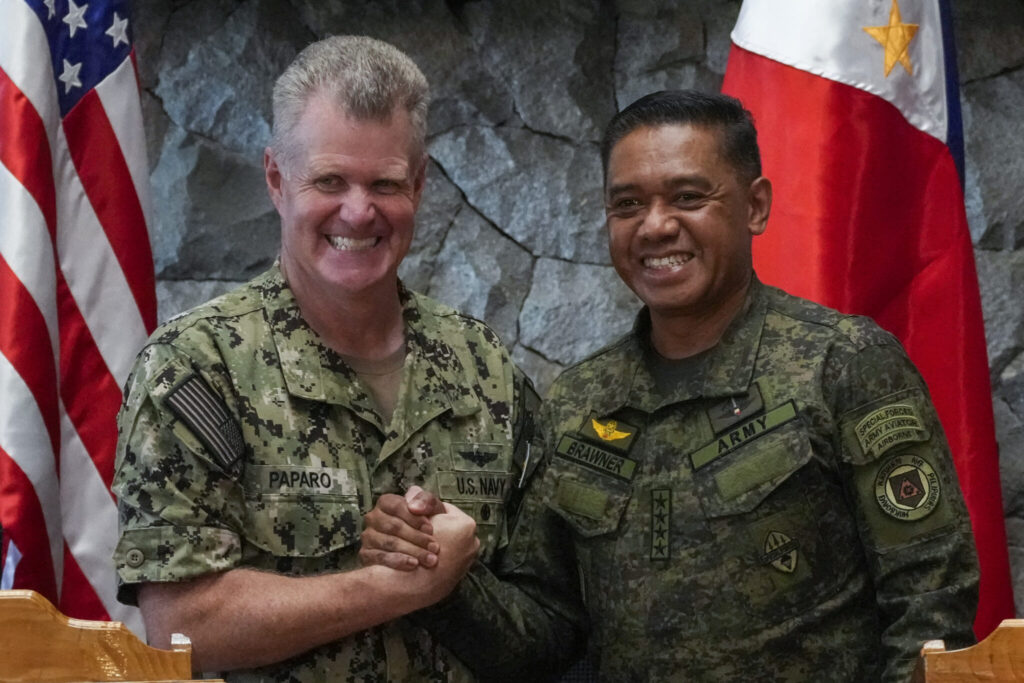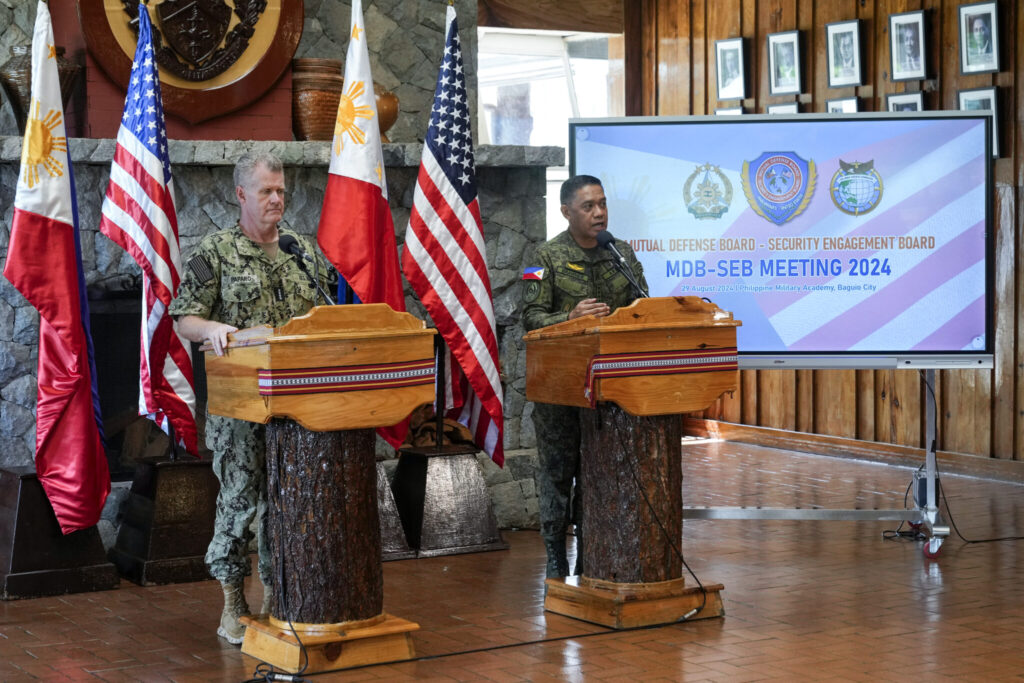American forces are ready with a “range of options” to deal with increasing acts of aggression in the disputed South China Sea if ordered to carry them out jointly and after consultations with treaty ally the Philippines, a U.S. admiral said Thursday. U.S. Indo-Pacific Command chief Adm. Samuel Paparo, who heads the biggest number of combat forces outside the U.S. mainland, refused to provide details of the contingency options. Paparo’s comments came when asked at a news conference what the longtime treaty allies could do to deal with China’s so-called gray-zone tactics in the disputed waters.
Quick Read
- U.S. Indo-Pacific Command chief Adm. Samuel Paparo stated that American forces are prepared with a “range of options” to address increasing aggression in the South China Sea, in coordination with the Philippines, if ordered.
- The “gray-zone tactics” used by China, such as water cannon fire and blocking rival ships, do not yet warrant invoking the 1951 Mutual Defense Treaty between the U.S. and the Philippines, but options are ready if needed.
- Paparo emphasized that detailing these options would risk enabling potential adversaries to develop countermeasures.
- The U.S. military is open to escorting Philippine ships in the South China Sea, which could lead to direct confrontations with Chinese vessels, depending on consultations between the two allies.
- Philippines Armed Forces Chief Gen. Romero Brawner Jr. expressed confidence in the country’s ability to defend itself in the disputed waters but acknowledged that U.S. assistance might be sought if other options are exhausted.
- Hostilities between China and the Philippines have escalated, with China using aggressive tactics against Filipino vessels near disputed shoals, leading to minor collisions and injuries.
- The Philippines continues to reference a 2016 international arbitration ruling that invalidated China’s extensive territorial claims in the South China Sea.
The Associated Press has the story:
US forces ready with a ‘range of options’ to deal with South China Sea aggression, US admiral says
Newslooks- BAGUIO, Philippines (AP) —
American forces are ready with a “range of options” to deal with increasing acts of aggression in the disputed South China Sea if ordered to carry them out jointly and after consultations with treaty ally the Philippines, a U.S. admiral said Thursday. U.S. Indo-Pacific Command chief Adm. Samuel Paparo, who heads the biggest number of combat forces outside the U.S. mainland, refused to provide details of the contingency options. Paparo’s comments came when asked at a news conference what the longtime treaty allies could do to deal with China’s so-called gray-zone tactics in the disputed waters.
The “gray-zone tactics” refer to types of assault, like water cannon fire and the blocking and ramming of rival ships in the disputed waters, that are under the threshold of an actual armed attack and wouldn’t allow the Philippines to invoke its 1951 Mutual Defense Treaty with the U.S. The treaty obligates either country to help the other in case of an armed external attack. “We certainly have prepared a range of options and USINDOPACOM stands ready, if so called, after consultations in accordance with the treaty to execute those shoulder to shoulder with our ally,” Paparo said.

Detailing those U.S. military options would allow “the potential adversary” to “build a countermeasure to those,” he said. Paparo held a joint news conference with Armed Forces of the Philippines chief Gen. Romero Brawner Jr., after both led an annual meeting in the northern Philippine mountain city of Baguio to discuss security challenges and military plans. They include the Balikatan — Tagalog for shoulder to shoulder — the treaty allies’ largest combat exercises, which in April involved more than 16,000 American and Filipinos forces and were partly staged in the South China Sea.
In response to a question, Paparo repeated that the U.S. military is open, after treaty consultations with the Philippines, to escorting Philippine ships in the South China Sea amid a spike in hostilities between Beijing and Manila in the disputed waters. Such a prospect would risk putting U.S. Navy ships in direct collisions with those of China.
Washington and Beijing have been on a collision course over China’s increasingly assertive actions to defend its territorial claims in the South China Sea, and Beijing’s stated goal of annexing Taiwan, by force if necessary. Brawner said the Philippines could still fend for itself in the disputed waters, where hostilities with the Chinese coast guard, navy and suspected militia ships have alarmingly spiked since last year. “If we exhaust all the options and nothing works, then that’s the time we can ask for help,” Brawner told reporters.
When Filipino forces in the disputed waters “are at the verge of dying,” because food supplies were being blocked by Chinese forces, “then that’s the time that we are going to seek the help of the United States,” Brawner said, but added that “we still have a lot of options.”

During combat exercises by U.S. and Philippine forces in April, the U.S. military transported a mid-range missile system to the northern Philippines, angering China, which warned that the missile system can trigger a regional arms race and endanger regional stability. Beijing demanded that the U.S. missile system, which can threaten mainland China, be pulled out of the Philippines.
Paparo and Brawner refused to say on Thursday if and when the missile system would be flown out of the Philippines. Brawner thanked the U.S. military for transporting the high-tech weaponry to the country, saying Filipino forces were being exposed to advance defense equipment that the Philippine military plan to acquire in the future. “Just like what we did with the Stingers and with the Javelins, we start training already even if we don’t have them yet in our inventory,” Brawner said.
China has angered the Philippines by repeatedly harassing its navy and coast guard ships with powerful water cannons, a military-grade laser, blocking movements and other dangerous maneuvers in the high seas near two disputed South China Sea shoals. They have led to minor collisions that have injured several Filipino navy personnel and damaged supply boats.
China has accused the Philippines of setting off the hostilities in the disputed waters by encroaching in what it says are its offshore territories, demarcated by 10 dashes on a map. It says the Chinese coast guard and navy have been forced to take action to expel Philippine coast guard and other vessels from those areas.
The Philippines has repeatedly cited a 2016 international arbitration ruling based on the U.N. Convention of the Law of the Sea that invalidated China’s claim over virtually the entire South China Sea on historical grounds.







